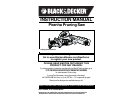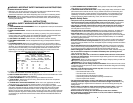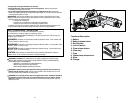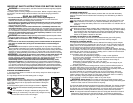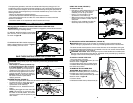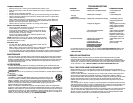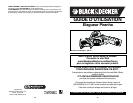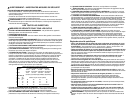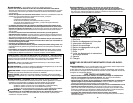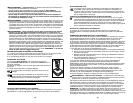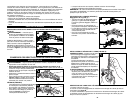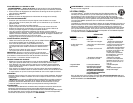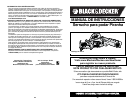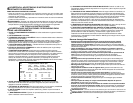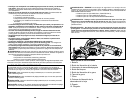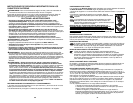
14.) KEEP HANDS AWAY FROM BLADES. Donʼt grasp the exposed cutting blade
when picking up or holding the appliance.
15.) MAINTAIN APPLIANCE WITH CARE - Keep cutting edge sharp and clean for best
performance and to reduce the risk of injury. Follow instructions for lubricating and
changing accessories. Inspect appliance cord periodically, and if damaged, have it
repaired by an authorized service facility. Inspect extension cords periodically and
replace if damaged. Keep handles dry, clean, and free from oil and grease.
Specific Safety Rules
• Hold power tools by insulated gripping surfaces when performing an operation
where the cutting tool may contact hidden wiring or its own cord. Contact with a
"live" wire will make exposed metal parts of the tool "live" and shock the operator.
• Use clamps or another practical way to secure and support the work piece to a
stable platform. Holding the work by hand or against your body leaves it unstable
and may lead to loss of control.
• Hold saw firmly for all cutting operations. During cutting operations, the blade may
suddenly bind in the work and may cause the saw to kickback towards the operator.
• Keep hands away from cutting area. Never reach underneath the material for any
reason. Hold front of saw by grasping the contoured gripping area. Do not insert fingers
or thumb into the vicinity of the reciprocating blade and blade clamp. Do not stabilize
the saw by gripping the shoe.
• Keep blades sharp. Dull blades may cause the saw to swerve or stall under pressure.
• Use extra caution when cutting overhead and pay particular attention to overhead
wires which may be hidden from view. Anticipate the path of falling branches and debris
ahead of time.
• Do not operate this tool for long periods of time. Vibration caused by the operating
action of this tool may cause permanent injury to fingers, hands, and arms. Use gloves
to provide extra cushion, take frequent rest periods and limit daily time of use.
• When cutting pipe or conduit ensure that they are free from water, electrical wiring, etc.
• Do not touch the workpiece or the blade immediately after operating the tool.
They can become very hot.
• When not in use, place tool on its side on a stable surface where it will not cause
a tripping or falling hazard. Some tools with large battery packs will stand upright but
may be easily knocked over.
WARNING: Never use the tool above shoulder height. Always position yourself out
of the path of falling branches and debris.
WARNING: Do not use this tool to fell trees.
• Pre-plan a safe exit from falling branches and debris. Ensure the exit route is clear
of obstacles that would prevent or hinder movement. Remember wet grass and freshly
cut bark is slippery.
• Be aware of the direction that a branch may fall. Consider all conditions that may
affect the direction of fall, including:
• The intended direction of fall.
• The natural lean of the branch.
• Any unusual heavy limb structure or decay.
• Surrounding trees and obstacles including overhead lines.
• The wind speed and direction.
• The safe distance between a branch and debris to be felled and bystanders,
buildings and other objects is at least 2 1/2 times the length of the branch. Any
bystander, building or object within this distance is at risk from being struck by the
falling branch.
• When cutting a limb that is under tension be aware of spring back. When the
tension in the wood fibers are released the spring loaded limb may strike the
operator and/or throw the tool out of control.
• Ensure someone is nearby (at a safe distance) in case of an accident.
• Do not attempt to operate the tool when in a tree, on a ladder or standing on
any other unstable support.
2 3
WARNING: IMPORTANT SAFETY WARNINGS AND INSTRUCTIONS
TO REDUCE RISK OF INJURY:
• Before any use, be sure everyone using this tool reads and understands all safety
instructions and other information contained in this manual.
• Save these instructions and review frequently prior to use and in instructing others.
WARNING: When using electric gardening appliances, basic safety precautions
should always be followed to reduce risk of fire, electric shock, and personal injury,
including the following:
READ ALL INSTRUCTIONS.
GENERAL SAFETY WARNINGS AND INSTRUCTIONS FOR ALL
TOOLS
1.) AVOID DANGEROUS ENVIRONMENT - Donʼt use appliances in damp or wet locations.
2.) DONʼT USE IN RAIN.
3.) KEEP CHILDREN AWAY - All visitors should be kept at a safe distance from the work
area.
4.) DRESS PROPERLY - Donʼt wear loose clothing or jewelry. They can be caught in
moving parts. Use of rubber gloves and substantial footwear is recommended when
working outdoors. Wear protective hair covering to contain long hair.
5.) USE SAFETY GLASSES - Also use face or dustmask if operation is dusty.
6.) USE RIGHT APPLIANCE - Do not use appliance for any job except that for which it is
intended.
7.) EXTENSION CORD. Make sure your extension cord is in good condition. When
using an extension cord be sure it is heavy enough to carry the current your product
will draw. An undersized extension cord will cause a drop in line voltage resulting in
loss of power and overheating. The following table shows the correct size to use
depending on cord length and nameplate ampere rating. If in doubt, use the next
heavier gage. The smaller the gage number, the heavier the cord.
8.) AVOID UNINTENTIONAL STARTING - Donʼt carry plugged in appliance with finger
on switch. Be sure switch is off when plugging in.
9.) DONʼT FORCE APPLIANCE. It will do the job better and with less likelihood of a risk
of injury at the rate for which it was designed.
10.) DONʼT OVERREACH - Keep proper footing and balance at all times.
11.) STAY ALERT - Watch what you are doing. Use common sense. Do not operate
appliance when you are tired.
12.) STORE IDLE APPLIANCE INDOORS - When not in use, appliances should be
stored indoors in a dry, and high or locked-up place- out of reach of children.
13.) CHECK DAMAGED PARTS - Before further use of the appliance a guard or other
part that is damaged should be carefully checked to determine that it will operate
properly and perform its intended function. Check for alignment of moving parts,
binding of moving parts, breakage of parts, mounting and any other condition that may
affect its operation. A guard or other part that is damaged should be properly repaired
or replaced by an authorized service center unless otherwise indicated elsewhere in
this manual.
Minimum Gauge for Cord Sets
Volts Total Length of Cord in Feet
120V 0-25 26-50 51-100 101-150
(0-7,6m) (7,6-15,2m) (15,2-30,4m) (30,4-45,7m)
240V 0-50 51-100 101-200 201-300
(0-15,2m) (15,2-30,4m) (30,4-60,9m) (60,9-91,4m)
Ampere Rating
More Not more American Wire Gauge
Than Than
0-6 18 16 16 14
6 - 10 18 16 14 12
10 - 12 16 16 14 12
12 - 16 14 12 Not Recommended



